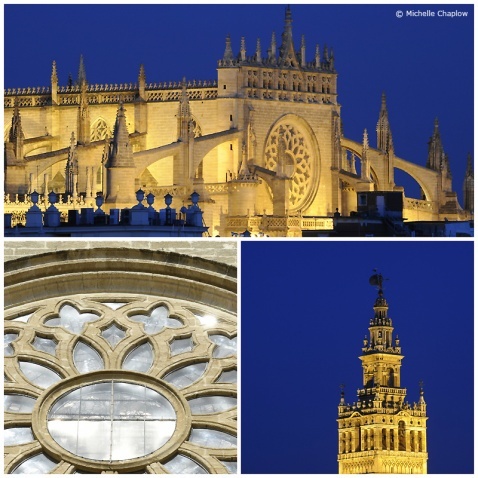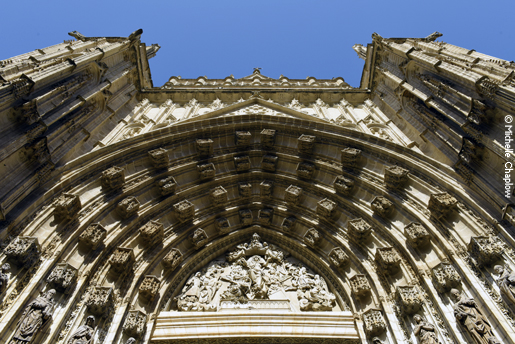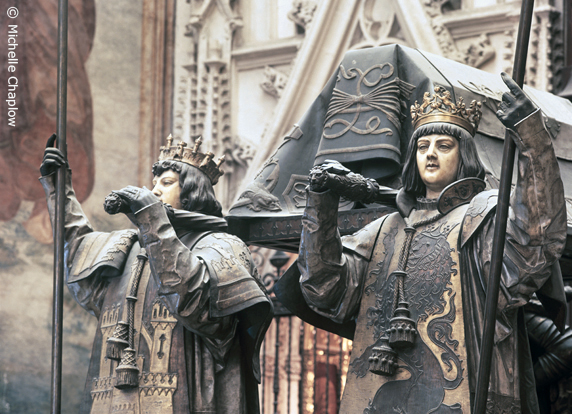
Sheer size and grandeur are, inevitably, the chief characteristics of the Cathedral |
|
Seville Cathedral
Take me to: Hotels near Seville Cathedral
Seville's cathedral, Santa Maria de la Sede, is the largest Gothic cathedral in the world, and is recognised as UNESCO World Heritage.
HISTORY
The cathedral's construction lasted over a century, from 1401 to 1506. It is said that when the plans were drawn up, church elders stated, "Hagamos una iglesia tan hermosa y tan grandiosa que los que la vieren labrada nos tengan por locos." (Let us build a church so beautiful and so magnificent that those who see it finished will think we are mad).
The basilica occupies the site of the great Aljama mosque, built in the late 12th century by the Almohads, the ruling Moorish dynasty, of which the only remaining parts are the Patio de Naranjas, the Puerta del Perdon (on Calle Alemanes, on the north side), and the Giralda (formerly the minaret, now the belltower).
SIZE
Its central nave rises to an awe-inspiring 42 metres and even the 80 side chapels each seem tall enough to contain an ordinary church. The total area covers 11,520m2 and according to some, new calculations, based on cubic measurements, have now pushed it in front of St Peter's in Rome and the Catedral Metropolitana Nossa Senhora Aparecida in Brazil as the largest church in the world. But this is still a subject for debate, and many claim it is still the third-largest in the world.
Sheer size and grandeur are, inevitably, the chief characteristics of the Cathedral, although two other qualities stand out with equal force - the rhythmic balance and interplay between the parts, and an impressive overall simplicity and restraint in decoration (apart from the Retablo Mayor). All successive ages have left monuments of their own wealth and style, but these have been restricted to the two rows of side chapels. In the main body of the cathedral only the great box-like structure of the coro (choir) stands out, filling the central portion of the nave.
Book Guided tour Seville Cathedral
Capilla Mayor AND RETABLO MAYOR
This opens onto the Capilla Mayor (Great Chapel), dominated by a vast Gothic retablo (altar piece) comprised of 45 carved scenes from the life of Christ, as well as Santa Maria de la Sede, the cathedral's patron saint. The lifetime's work of a single craftsman, Pierre Dancart, this is the ultimate masterpiece of the cathedral - the largest and richest altarpiece in the world and one of the finest examples of Gothic woodcarving anywhere. The guides provide staggering statistics on the amount of gold involved.
At the end of the first aisle are a series of rooms designed in the rich Plateresque style in 1530 by Diego de Riano, one of the foremost exponents of this predominantly decorative architecture of the late Spanish Renaissance.
CAPITULAR AND SACRISTIA MAYOR
Through the ante-chamber, you reach the Capitular (Chapter House) with its magnificent domed ceiling mirrored in the marble decoration of the floor. There are a number of paintings by Murillo here, the finest of which, a flowing Conception, occupies the place of honour.
 |
| The Gothic Cathedral of Seville - Puerta de la Asuncion. © Michelle Chaplow |
Alongside this room is the grandiose Sacrista Mayor (Great Sacristy) which houses the treasury. Amid a confused collection of silver reliquaries and monstrances are the keys presented to Fernando by the Moorish and Jewish communities on the surrender of the city, sculpted into the latter in stylised Arabic script are the words 'May Allah render eternal the dominion of Islam in the city.'
The tomb of Christopher Columbus
This is one of the main attractions of the cathedral for visitors, housing the remains of the great explorer who died in poverty in Valladolid. The tomb itself is more recent, from the 1892, with four bearers presenting the kingdoms of Castile, Leon, Aragon and Navarra.
 |
| The Tomb of Christopher Columbus in Seville Cathedral © Michelle Chaplow |
Other cities claim to hold the remains of Cristobal Colon, as he is known in Spanish - Havana, Cuba, and Santo Domingo in the Domican Republic - but recent DNA tests proved beyond doubt that this tomb does hold Columbus. The next-door chapel with 14th-century frescoes of the Virgin, once contained the mihrab of the mosque.
THE CROCODILE
The stuffed crocodile, known as El Lagarto is always a fun spot for kids. It was a gift from the Sultan of Egypt to King Alfonso X, for asking for the hand in marriage of his daughter Berenguela. Although the Sultan did not wed the princess in the end, the crocodile stayed, and was stuffed. Now it is one of the cathedral's quirkier relics.
Giralda
The climb to the top of Giralda is considered well worth the effort for the views alone.
Patio de los Naranjos
You walk through this large courtyard contained within the cathedral precinct as you leave the cathedral. The Patio de los Naranjos dates back to Moorish times when worshippers would wash their hands and feet in the fountains here - under the orange trees - before their five daily prayer sessions. As leave the Patio, you pass through the Puerta del Perdon (Gate of Forgiveness), a stucco engraved horse-shoe shaped masterpiece, also dating from the original Almohad mosque.
Opening Hours of cultural visits
Monday: 11:00 to 15:30 (16:30 to 18:00 free audioguide when reserved in advance)
Tuesday to Saturday: 11:00 to 17:00
Sunday: 14:30 to 18:00
The ticket office closes one hour before the cathedral closes (sometimes even earlier).
On occasions there are special services which impact on the hours of the 'Cultural visits'. You can check these on the calendar on the Cathedral website.
Mass is also held at eight to nine (summer) and eight to ten thirty (winter) in the morning, naturally there is no fee to attend mass.
Admission
General: 9 €
Pensioners and Students 4 €
Seville residents, under 14yrs, disabled, unemployed: free
